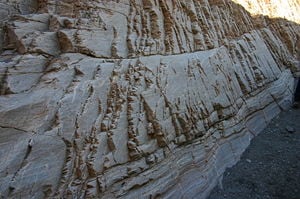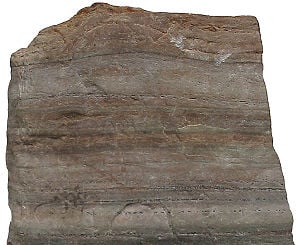Metamorphic rock
Metamorphic rock is produced deep beneath the Earth's surface when a pre-existing rock type, called the protolith, is transformed under conditions of high temperatures and pressures. The protolith may be sedimentary rock, igneous rock, or older metamorphic rock, and the transformation may involve physical changes, chemical changes, or both. The process of change is called metamorphism, which means "change in form."
Metamorphic rocks are widespread in the Earth's crust. The study of metamorphic rocks, many of which have become exposed at the Earth's surface following erosion and uplift, provides us with valuable information about the temperatures and pressures occurring at great depths within the Earth's crust. Some examples of metamorphic rocks are gneiss, slate, marble, and schist. The rocks are classified by texture and by chemical and mineral assemblage.
Minerals in metamorphic rocks
Some minerals, called metamorphic minerals, are formed only at the high temperatures and pressures associated with the process of metamorphism. Also known as index minerals, they include sillimanite, kyanite, staurolite, andalusite, and some garnet.
Other minerals—such as olivines, pyroxenes, amphiboles, micas, feldspars, and quartz—may also be found in metamorphic rocks, but they are not necessarily the result of the process of metamorphism. They were formed during the crystallization of igneous rocks. Being stable at high temperatures and pressures, they may remain chemically unchanged during the metamorphic process. Nonetheless, all minerals are stable only within certain limits, and the presence of some minerals in metamorphic rocks indicates the approximate temperatures and pressures at which they were formed.
Recrystallization
During the process of metamorphism, the particle size of the rock may change by a process called recrystallization. For instance, the small calcite crystals in limestone, a sedimentary rock, change into larger crystals during formation of the metamorphic rock marble. In the case of metamorphosed sandstone, recrystallization of the original quartz sand grains results in very compact quartzite, in which the often larger quartz crystals are interlocked.
Both high temperatures and pressures contribute to recrystallization. High temperatures allow the atoms and ions in solid crystals to migrate, thus reorganizing the crystals. High pressures cause solution of the crystals within the rock at their points of contact.
Chemical changes
The process of metamorphism may also involve chemical reactions between minerals, even if they are not in the molten state. In this case, the minerals exchange atoms and new minerals are formed. Many complex reactions may take place, and each resultant mineral assemblage provides us with a clue regarding the temperatures and pressures at the time of metamorphism.
Metasomatism is the drastic change in the bulk chemical composition of a rock, due to the introduction of chemicals from other surrounding rocks. Hot water and other fluids may transport these chemicals rapidly over great distances. Based on the role played by water, metamorphic rocks generally contain many elements that were absent from the original rock, and they lack some that were originally present.
Foliation

The layering within metamorphic rocks is called foliation, and the rock is known as foliated or banded rock. The term "foliation" is derived from the Latin word folia, which means "leaves."
Foliation occurs when a strong compressive force is applied to a recrystallizing rock from one direction. Consequently, the platy or elongated crystals of some minerals (such as mica or chlorite) grow with their long axes perpendicular to the direction of the force. This process results in foliated rock, in which the bands display the colors of the minerals that formed them.
By contrast, rocks that were subjected to uniform pressure from all sides, or those that lack minerals with distinctive growth habits, will not be foliated. Non-foliated rocks do not have planar patterns of stress.
On this basis, metamorphic rocks can be categorized as foliated or non-foliated. For example, slate is a foliated metamorphic rock, originating from shale. Slate is very fine-grained, phyllite is coarse, schist is coarser, and gneiss is very coarse-grained. Marble is generally not foliated, allowing it to be used for sculpture and architecture.
Metamorphic rock textures
There are five basic metamorphic rock textures. They are listed below, along with the typical corresponding rock types.
- Slaty: slate and phyllite
- Schistose: schist
- Gneissic: gneiss
- Granoblastic: granulite, some marbles, and quartzite
- Hornfelsic: hornfels and skarn
Two main types of metamorphism
Metamorphic rocks may be formed by two major routes. They are called regional metamorphism and contact metamorphism.
Regional metamorphism
The transformation of great masses of rock, often within orogenic (mountain-forming) belts, is known as regional metamorphism. The changes are caused by high temperatures and pressures in the depths of the Earth. When the metamorphosed rocks are uplifted and exposed by erosion, they are found over vast areas at the surface.
The process of metamorphism may destroy the original features that could have revealed the rock's earlier history. Recrystallization of the rock destroys the textures and fossils present in sedimentary rocks. Metasomatism changes the original chemical composition of the rock.
Regional metamorphism tends to harden the rock and to give it a foliated, schistose or gneissic texture, with a planar arrangement of the minerals. Schistosity and gneissic banding are the two main types of foliation. They are produced by directed pressure at elevated temperature, and by interstitial movement (internal flow) that arranges the mineral particles while they are crystallizing in that pressure field.
In this process, platy or prismatic minerals like mica and hornblende have their longest axes arranged parallel to one another. For that reason, many of these rocks split readily in one direction along mica-bearing zones (schists). In gneisses, minerals also tend to be segregated into bands.
A mica schist consists of seams of quartz and mica. The rocks will split most readily along the mineral layers that are soft or fissile, and a freshly split specimen may appear to be coated with this mineral. For example, a piece of mica schist looked at facewise might appear to consist entirely of shiny scales of mica, but white folia of granular quartz will be visible along the specimen’s edges.
In gneisses, these alternating folia are sometimes thicker and less regular than in schists, but most important, they are less micaceous. Gneisses also, as a rule, contain more feldspar than schists do, and they are tougher and less fissile. Contortion or crumbling of the foliation is by no means uncommon, and the splitting faces are undulose or puckered.
Contact metamorphism
When magma is injected into the surrounding solid rock (called country rock), the changes that take place are known as contact metamorphism. The changes are greatest in the zones where the magma comes into contact with the country rock. As the magma cools and solidifies, it forms igneous rock, and surrounding the igneous rock is a metamorphosed zone called a contact metamorphism aureole. Aureoles may show various degrees of metamorphism from the contact area to unmetamorphosed (unchanged) country rock some distance away.
When a rock is contact altered by an igneous intrusion, it frequently undergoes hardening and becomes more coarsely crystalline. Many altered rocks of this type were formerly called hornstones, and geologists often use the term hornfels to signify those fine-grained, compact, non-foliated products of contact metamorphism.
If the rock was originally foliated, this character may not be obliterated, and a banded hornfels is produced. Fossils may have their shapes preserved, though entirely recrystallized, and the vesicles in many contact-altered lavas are still visible, though their contents have usually formed minerals that were not originally present. If the thermal alteration is very profound, the minute structures disappear, often completely. Thus small grains of quartz in shale are lost or blend with the surrounding particles of clay, and the fine ground-mass of lavas is entirely reconstructed.
The recrystallization process often produces distinct types of rocks. Thus shales may pass into cordierite rocks, or may show large crystals of andalusite, staurolite, garnet, kyanite, and sillimanite, all derived from the aluminous content of the original shale. Often, a considerable amount of mica is simultaneously formed, and the resulting product closely resembles many kinds of schist. Limestones, if pure, are often turned into coarsely crystalline marbles. Sandstones, when heated, may change into coarse quartzites composed of large clear grains of quartz. Such intense stages of alteration are not so commonly seen in igneous rocks, because their minerals, being formed at high temperatures, are not so easily transformed or recrystallized.
In some cases, rocks are fused, and minute crystals of spinel, sillimanite, and cordierite may separate out in the dark glassy product. Thus shales are occasionally altered by basalt dikes, and feldspathic sandstones may be completely vitrified. Similar changes may be induced in shales by the burning of coal seams or even by an ordinary furnace.
There is also a tendency for metasomatism between the igneous magma and sedimentary country rock, whereby they exchange chemicals with each other. Granites may absorb fragments of shale or pieces of basalt. In that case, hybrid rocks called skarn arise. On rare occasions, an invading granite magma permeates the surrounding rocks, filling their joints and planes of bedding with threads of quartz and feldspar.[1]
See also
Notes
- ↑ This article incorporates text from the Encyclopædia Britannica Eleventh Edition, a publication now in the public domain.
ReferencesISBN links support NWE through referral fees
- Best, Myron G. 2003. Igneous and Metamorphic Petrology. 2nd ed. Oxford, UK: Blackwell. ISBN 1405105887
- Blatt, Harvey, and Robert J. Tracy. 1995. Petrology: Igneous, Sedimentary, and Metamorphic, 2nd ed. New York: W.H. Freeman. ISBN 0716724383
- Pellant, Chris. 2002. Rocks and Minerals. Smithsonian Handbooks. New York: Dorling Kindersley. ISBN 0789491060
- Shaffer, Paul R., Herbert S. Zim, and Raymond Perlman. 2001. Rocks, Gems and Minerals. Rev. ed. New York: St. Martin's Press. ISBN 1582381321
- Skinner, Brian J., Stephen C. Porter, and Jeffrey Park. 2004. Dynamic Earth: An Introduction to Physical Geology. 5th ed. Hoboken, NJ: John Wiley. ISBN 0471152285
- Winter, John D. 2001. An Introduction to Igneous and Metamorphic Petrology. Upper Saddle River, NJ: Prentice Hall. ISBN 0132403420
External links
All links retrieved November 9, 2022.
- Types of Metamorphism Tulane University.
Credits
New World Encyclopedia writers and editors rewrote and completed the Wikipedia article in accordance with New World Encyclopedia standards. This article abides by terms of the Creative Commons CC-by-sa 3.0 License (CC-by-sa), which may be used and disseminated with proper attribution. Credit is due under the terms of this license that can reference both the New World Encyclopedia contributors and the selfless volunteer contributors of the Wikimedia Foundation. To cite this article click here for a list of acceptable citing formats.The history of earlier contributions by wikipedians is accessible to researchers here:
The history of this article since it was imported to New World Encyclopedia:
Note: Some restrictions may apply to use of individual images which are separately licensed.
